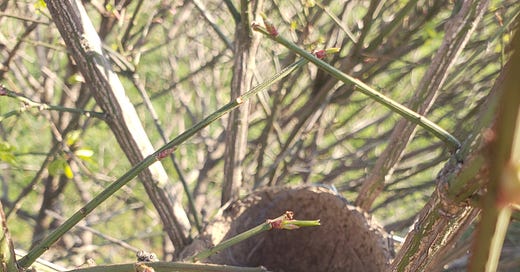Be Ready as Natural and Manmade Disasters will Strike your American Family
Even though most Americans believe they only happen to someone else
The reality is, natural and manmade disasters, will strike your American family.
To better understand the threat, go to Disaster News on X. It is an excellent resource to follow to see how a manmade or natural disasters strike somewhere everyday…all day. Disaster News on Telegram is also an excellent resource for the same information.
Natural Disasters in the U.S.
The estimates below are based on National Oceanographic and Atmospheric Administration (NOAA), Census Bureau, and Environmental Protection Agency (EPA) data, and the Federal Emergency Management Agency. Unfortunately, no one federal government agency keeps statistics on the total number of Americans impacted by disasters each year so I could only cobble together the following limited estimates.
Natural disasters dominate the disaster world due to their frequency and scale. Approximately 3–10 million Americans experience natural disasters annually such as hurricanes, wildfires, and floods, that affect 3–5 million directly (displacement, property damage) and up to 10 million indirectly (economic disruption).
In 2017, FEMA reported that unprecedented disasters affected more than 25 million Americans (about 8% of the U.S. population), a figure tied to major events like hurricanes and wildfires.
From December 2022 to October 2023, the Census Bureau’s Household Pulse Survey reported that 1.2–1.7% of respondents (averaging 3.1 million people) were displaced by natural disasters. This figure only captures displacement and not broader impacts like property damage or economic disruption, so the total affected is likely higher, underscoring the need for readiness.
NOTE: The numbers of Americans impacted by natural disasters are much higher as disasters that do not result in a federal declaration are not counted and, therefore, they are not included in the statistics above.
Manmade Disasters in the U.S.
Manmade disasters, such as chemical spills or industrial accidents, directly impact 50,000–100,000, with indirect effects reaching 1–2 million in significant years.
However, if we include the greatest manmade disaster, kinetic war (World War I, World War II, Joseph Stalin’s murders and gulags and Mao’s mass Cultural Revolution killings, over 160 million people died in such manmade disasters in just the last century.
More recent manmade disasters, such as the Chinese Communist Party release of the Covid 19 bioweapon, have resulted in millions of additional deaths. Manmade disasters cause more concentrated death and destruction than natural disasters.
And with the increasing specter of the latest cyberwar manmade disaster, low-level cyberwarfare that can blossom into high-level cyberwarfare, and its related technology, artificial intelligence, manmade disasters will increase exponentially.
What you can do to Prepare for Disasters
Average Americans can prepare for natural disasters by taking practical, family friendly, positive, proactive steps to ensure safety, minimize damage, mitigate danger, and maintain resilience.
1. Make a Plan
Identify potential disasters in your area (e.g., floods in low-lying areas, earthquakes in seismic zones).
Plan evacuation routes and safe locations (e.g., higher ground for floods, open fields for tornadoes).
Designate a meeting point for family members if separated.
Include pets in your plan (e.g., identify pet-friendly shelters).
Establish an out-of-state contact to coordinate messages if local lines are down. Write down important numbers on paper. Keep them in your wallet or purse.
Ensure everyone has a list of emergency contacts (family, local authorities, insurance).
Learn how to receive alerts (e.g., NOAA Weather Radio, FEMA app, local alert systems).
Practice Drills
Rehearse evacuation or shelter-in-place procedures (e.g., “drop, cover, hold on” for earthquakes).
Test communication plans with family or housemates.
2. Build an Emergency Kit
Basic Supplies (3–7 Days)
Water: 1 gallon per person per day (3-day minimum, 2 weeks ideal)
Food: Non-perishable items (e.g., packaged food, canned goods, protein bars, manual can opener)
First aid kit: Bandages, antiseptic, prescription medications (7-day supply)
Flashlights, extra batteries, or hand-crank lights
Multi-tool, duct tape, and sturdy gloves
Warm clothing, blankets, and sturdy shoes
Disaster-Specific Items
Floods: Waterproof bags for documents, sandbags for barriers
Wildfires: N95 masks, goggles for smoke protection
Earthquakes: Secure heavy furniture, have a fire extinguisher
Personal Items
Copies of IDs, insurance policies, and medical records (in waterproof container, safe box, and digital backup)
Cash (ATMs may be down)
Phone chargers, portable phone battery packs
3. Protect Your Home
Structural Preparations
Hurricanes: Install storm shutters, reinforce garage doors, elevate appliances above flood levels, and add hurricane strap tiedowns to all the beams in your attic.
Earthquakes: Bolt bookcases and water heaters to walls, secure heavy objects, download an app that warns you about an upcoming earthquake.
Wildfires: Create a defensible space (clear brush 30–100 feet from home), use fire-resistant roofing.
Floods: Elevate utilities (furnace, water heater), seal basement walls, be aware of the flood threat to your home, and buy flood insurance if you are located on a flood plain.
Insurance
Review your homeowners or renters insurance; standard policies often exclude floods or earthquakes. When our house burned down in 2024, our homeowners insurance enabled us to rebuild and start over.
Consider flood insurance through the National Flood Insurance Program (NFIP) or private insurers (30-day waiting period applies).
Document possessions (photos, videos) for insurance claims. This is critical. You will need to prove to your insurance company you owned the items for which you seek reimbursement.
Maintenance
Clear gutters, trim trees, and check roof integrity to reduce storm damage.
Test smoke and carbon monoxide detectors regularly.
4. Stay Informed
Monitor Alerts
Sign up for community alert systems (Reverse 911, country emergency text alerts, for example).
Keep a battery-powered or hand-crank radio for updates during power outages.
Understand Local Risks
Check FEMA flood maps, USGS earthquake hazard maps, or other deep government data, if rarely used, websites to assess your area’s risks.
Learn local shelter locations and evacuation routes.
Learn Skills
Take first aid, CPR, or Community Emergency Response Team (CERT) training.
I encourage you to learn basic trade skills (power saw operation, plumbing, carpentry, stone masonry, mechanics, electrical work, etc.) as well as they are critical to recovery efforts.
Know how to shut off utilities (gas, water, electricity) to prevent hazards.
5. Community and Financial Preparedness
Engage with Community
Join neighborhood preparedness groups or CERT programs to coordinate resources.
Help vulnerable neighbors (elderly, disabled) with their plans.
Financial Resilience
Set aside an emergency fund (even $500 can help).
Back up financial records digitally and store copies off-site.
Understand FEMA assistance eligibility and limits (e.g., grants for temporary housing, not full rebuilding). As they learned in Western North Carolina recently, FEMA only helps a few in a disaster.
6. Specific Disaster Tips
Hurricanes: Board windows, stock sandbags, evacuate if ordered (coastal areas).
Earthquakes: Secure heavy items, practice “drop, cover, hold on,” avoid glass-heavy areas.
Floods: Move valuables to higher floors, avoid driving through floodwater (6 inches can sweep a car away).
Wildfires: Evacuate early, seal windows/doors, keep air filters clean post-fire.
Tornadoes: Identify a safe room (basement, interior room on lowest floor), monitor watches and warnings.
Practical Tips for Average Americans
Start Small: Build your kit over time (add a few items per grocery trip). Preparing is easy. Just obtain what you need. Do not overbuy. Visit the TACDA Survival Store for vetted, good, practical supplies on a well organized, easy to use, survival rich product website.
Use Free Resources: The American Civil Defense Association, the Journal of Civil Defense, and American Tactical Civil Defense Substack.
Involve Family: Teach children and grandchildren emergency numbers and plans in age-appropriate ways. This is critical. In this age of cell phones, everyone has their emergency numbers stored on their phones. Back them up on paper and place a copy in your wallet or purse.
Check Annually: Refresh kit supplies, update documents, and review plans. Check your supplies for spoilage. I had dozens of MRE’s go bad over the years. Just rotate your stock and you will be good.
Learning to Have Faith
Brannan’s 14-month old fingers
Squeezed hard my index finger
As his legs pumped forward
Hesitatingly, then confidently,
As he learned to take rapid steps
In his first explorations of the grass
On his bare feet each time the
Earth was still there beneath him.
He soon had faith that he could coordinate
His sight, muscle, and sensory nerve endings
To march further into the before unknown.
The strength of his fingers on mine
Startled me and made me focus
On keeping up with his gait
And not letting him fall or stumble
Until I felt, as real as his fingers
Wrapped mightily around mine,
God’s hand holding my other hand
Not letting me fall or stumble
So I, in faith, too, would not let Brannan
Fall or stumble, despite the Original Fall,
Despite my unworthy sin stumbles.







